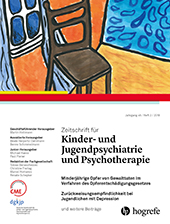Usual Care for Maltreatment- Related Pediatric Posttraumatic Stress Disorder in Germany
Abstract
Abstract. Child maltreatment represents a major risk factor for the development of emotional and behavioral problems, especially posttraumatic stress disorder (PTSD). While effective trauma-focused treatments are available, little is known about the usual mental healthcare for abused youths in Germany. The present study compared the utilization of mental healthcare in abused youths who had developed a PTSD (N = 95) with a group presenting other mental disorders (N = 146). Semistructured interviews were used to assess maltreatment histories, current mental health, and healthcare utilization. In addition, potential child factors associated with access to mental healthcare (age and level of functioning) were examined. Results showed that 65 % of both diagnostic groups currently fail to use any mental healthcare service. Of the participants with PTSD, 43 (45 %) had never received any mental healthcare intervention. Investigations on potential barriers are necessary to close the huge gap between clinical services and evidence-based, trauma-focused interventions.
Zusammenfassung. Kindesmisshandlung, -missbrauch und -vernachlässigung stellen Risikofaktoren für die Entwicklung emotionaler Probleme und Verhaltensauffälligkeiten dar, insbesondere für die Entwicklung einer Posttraumatischen Belastungsstörung (PTBS). Während wirksame traumafokussierte Therapien verfügbar sind, ist bisher wenig über die übliche psychiatrisch/psychotherapeutische Versorgung misshandelter Kinder und Jugendlicher in Deutschland bekannt. Die vorliegende Untersuchung vergleicht daher die Inanspruchnahme psychiatrischer und psychotherapeutischer Hilfen durch misshandelte Kinder und Jugendliche, welche eine PTBS entwickelt haben (N = 95), mit einer Gruppe, welche andere psychische Störungen aufweist (N = 146). Mittels semistrukturierter klinischer Interviews wurden die Misshandlungsanamnese, die aktuelle psychische Gesundheit sowie die in Anspruch genommenen Hilfen erhoben. Des Weiteren wurden Faktoren untersucht, welche möglicherweise mit dem Zugang zu therapeutischer Versorgung assoziiert sind (aktuelles Alter und psychosoziales Funktionsniveau). Die Ergebnisse zeigen, dass innerhalb beider Untersuchungsgruppen 65 % der Kinder und Jugendlichen aktuell keine psychiatrischen und psychotherapeutischen Hilfen in Anspruch nehmen. Dreiundvierzig Studienteilnehmer mit einer PTBS (45 %) hatten vor Studienteilnahme noch nie eine Therapie erhalten. Daher ist die Untersuchung von Barrieren notwendig, welche die Dissemination evidenzbasierter Therapien für misshandelte Kinder und Jugendliche möglicherweise erschweren.
Literature
(2012). Sexual victimization of children and adolescents in Switzerland: Final report for the UBS Optimus Foundation. Zurich, Switzerland: UBS Optimus Foundation.
, (2004). Mental health need and access to mental health services by youths involved with child welfare: A national survey. Journal of the American Academy of Child & Adolescent Psychiatry, 43, 960–970.
(2010). Practice parameter for the assessment and treatment of children and adolescents with posttraumatic stress disorder. Journal of the American Academy of Child and Adolescent Psychiatry, 49, 414–430.
(2000). KIDDIE-SADS-Present and Lifetime Version (K-SADS-PL). 3rd ed. of the German research version. Frankfurt am Main: Klinik für Psychiatrie und Psychotherapie des Kindes-und Jugendalters der Universität Frankfurt.
(2013). Positionspapier – Psychotraumatologische Versorgung und Forschung in Deutschland, Österreich und der Schweiz. Bonn: Deutschsprachige Gesellschaft für Psychotraumatherapie (DeGPT e. V.).
(2005). The Juvenile Victimization Questionnaire: Reliability, validity, and national norms. Child Abuse & Neglect, 29, 383–412.
(2013). Statistical methods for rates and proportions (3rd ed.). New York: Wiley.
). (2008). Effective treatments for PTSD: Practice guidelines from the International Society for Traumatic Stress Studies. New York: Guilford.
(2007). Psychiatric disorder among British children looked after by local authorities: comparison with children living in private households. The British Journal of Psychiatry, 190, 319–325.
(2016). Kinder und Jugendliche mit Misshandlungserfahrungen: bekommen sie die Versorgung, die sie brauchen? Bundesgesundheitsblatt-Gesundheitsforschung-Gesundheitsschutz, 59, 803–810.
, (2017). Effectiveness of manualized case management on utilization of evidence-based treatments for children and adolescents after maltreatment: A randomized controlled trial. Child Abuse and Neglect, 67, 371–382.
(1996). Type of maltreatment as a predictor of mental health service use for children in foster care. Child Abuse and Neglect, 20, 675–688.
(2013). Psychological therapies for the treatment of post-traumatic stress disorder in children and adolescents (Review). Evidence-Based Child Health: A Cochrane Review Journal, 8, 1004–1116.
(2016). Effectiveness of trauma-focused cognitive behavioral therapy for children and adolescents: A randomized controlled trial in eight German mental health clinics. Psychotherapy and Psychosomatics, 85, 159–170.
(1994). The Children’s Global Assessment Scale in clinical practice: An empirical evaluation. Journal of the American Academy of Child and Adolescent Psychiatry, 33, 1158–1164.
(2004). The Juvenile Victimization Questionnaire (JVQ): Administration and scoring manual. Durham, NH: Crimes Against Children Research Center.
, (2015). Mental healthcare use among children and adolescents in Germany: Results of the longitudinal BELLA study. European Child and Adolescent Psychiatry, 24, 705–713.
(1997). Use of the Child and Adolescent Functional Assessment Scale to predict service utilization and cost. The Journal of Behavioral Health Services and Research, 24, 278–290.
(1997). Factors affecting utilization of treatment services by sexually abused girls. Child Abuse and Neglect, 21, 35–48.
(1996). Kiddie-Sads Present and Lifetime version (K-SADS-PL). Pittsburgh: University of Pittsburgh, School of Medicine.
(2010). Posttraumatic stress disorder in abused youth: A review of contemporary research and thought. Clinical Child and Family Psychology Review, 13, 46–76.
(2011). Evaluation of the sustainability and clinical outcome of Alternatives for Families: A Cognitive-Behavioral Therapy (AF-CBT) in a child protection center. Child Abuse and Neglect, 35, 105–116.
(2009). Ambulante Versorgung kinder- und jugendpsychiatrischer Störungen – Daten einer versichertenbezogenen epidemiologischen Studie. Praxis der Kinderpsychologie und Kinderpsychiatrie, 58, 170–185.
(2004). Outpatient mental health services for children in foster care: A national perspective. Child Abuse and Neglect, 28, 697–712.
(2015). Traumaanamnese und posttraumatische Stresssymptomatik in einer kinder- und jugendpsychiatrischen Inanspruchnahmepopulation. Psychiatrische Praxis, 42, 96–101.
(2002). Barriers to children’s mental health services. Journal of the American Academy of Child and Adolescent Psychiatry, 41, 731–738.
(2007). Psychische Gesundheit von Kindern und Jugendlichen in Deutschland. Bundesgesundheitsblatt-Gesundheitsforschung-Gesundheitsschutz, 50, 871–878.
(2004). Global assessment of psychosocial functioning in child and adolescent psychiatry. European Child and Adolescent Psychiatry, 13, 273–286.
, (1983). A children’s global assessment scale (CGAS). Archives of General Psychiatry, 40, 1228–1231.
(1999). Barriers and facilitators to use of services following intensive family preservation services. The Journal of Behavioral Health Services and Research, 26, 39–49.
(2003). Help seeking for emotional and behavioural problems in children and adolescents. European Child and Adolescent Psychiatry, 12, 153–161.



